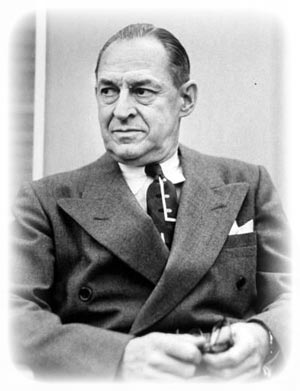 Ben Bernanke has said many times that Marriner Eccles, the head of the Federal Reserve in 1936/37 made a mistake by tightening credit (raising reserve requirements). Bernanke blames Eccles’s actions for the 50% stock market collapse in 1937 and the second leg of the depression that followed.
Ben Bernanke has said many times that Marriner Eccles, the head of the Federal Reserve in 1936/37 made a mistake by tightening credit (raising reserve requirements). Bernanke blames Eccles’s actions for the 50% stock market collapse in 1937 and the second leg of the depression that followed.
Bernanke’s interpretation of Eccles’s actions is widely held by historians. It was FDR who first (conveniently) blamed the Fed. I think that Bernanke is also (conveniently) blaming Eccles. He is using history's interpretation to support his position that monetary policy must be set on MAX for the next three years. He has said that he will not make the same mistake that poor old Eccles made.
Eccles was in a bind. His job at the Fed was to maintain relative stability of prices and the stock of money. In the years prior to 1937 money flowed into the USA from Europe. This "flight capital" fled to the USA in the form of gold shipments. The money came because the holders of wealth were anticipating a major war. With gold reserves rising, so did the supply of money. M1 increased 55%, and money in demand accounts rose 71% from 1933 to 1936. More troubling were rising inflationary pressures. In the first six-months of 1936, wages rose by 11%. Wages in the critical steel industry rose by 33%. These conditions would scare any reasonable Central Banker.
The Fed itself answered the historical question of whether the Fed’s actions in 1936-37 was responsible for the 1937-38 double dip. In a research paper, (PDF Link) St. Louis Fed researcher Charles Calomiris concluded:
We find that despite being doubled, reserve requirements were not binding on bank reserve demand in 1936 and 1937, and therefore could not have produced a significant contraction in the money multiplier.
Much of today’s monetary policy is based on the historical interpretation of the consequences of the Fed’s actions. If the Fed was not to blame for the 1937 crash, then who/what was? In her book, “The Forgotten Man”, Amity Shlaes provides some answers. She points to a critical speech by then Treasury Secretary Morgenthau on November 10, 1936:
The war against the Depression had required deficit spending. But the emergency is ending, and the domestic problems we face today are essentially different from those which faced us four years ago. We want private business to expand. We believe that one of the most important ways of achieving these ends is to continue toward a balance in the federal budget.
Morgenthau’s comments 75 years ago (and the following cut backs in federal spending that took place in 1937) remind me of where we sit today. After four-years of spending like mad to fight the recession/depression of 2008, the federal government has committed itself to dramatic cuts in spending starting in January of 2013. Coupled with those cuts are across the board tax increases for every individual who has income.
In the book, Shlaes points to other factors that contributed to the crash of '37:
*The rapid rise of wages/raw materials in 36/37 led to a conclusion by many that corporations were going to face a profit squeeze. It was this threat that led to the 1937 stock market fall. We face a similar situation today. Rising commodity prices and global wages will impact consumers and company’s bottom line. (Think Apple and Foxconn)
*Social Security was collecting money from every paycheck by 1937. This reduced disposable income and contributed to the recession. This is not unlike what we face in 2013 when SS taxes are scheduled to rise by 2%.
*FDR wanted to balance the budget. He raised taxes in 1937; this was a big factor in the decline of the economy. We face the same scenario in 2013 when large increases in taxes are scheduled.
*In November of 1936 Nazi Germany signed the Anti-Comintern Act with Japan and Italy. While there were many like Neville Chamberlain, who ignored the evidence that a war was coming, the financial markets did not. This too, has similarities with 2012.
I think we are about to re-make many of the mistakes of 1936/37. The programmed spending cutbacks, couple with the many impending tax increases on 1/1/2013, will certainly cause a sharp contraction in economic activity.
Bernanke’s Fed has sworn that it won’t make the mistakes of 1936/37. But I've shown (and the Fed’s own research confirms) that Fed policy was not the cause of the '37 crash. Bernanke is relying on a false interpretation of history to justify his monetary policy today.
We will face an economic slowdown due to lower federal spending, and at the same time, inflation will be rising as a result of the excessively loose monetary policy. Stagflation is in our future. Should this be the result, the historians will say that both the Fed and fiscal policy are to blame. In other words, we have not learned a thing from our past mistakes.
Source: BruceKrasting.blogspot.com








